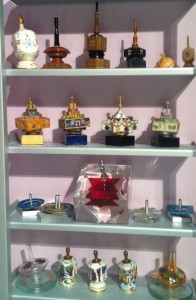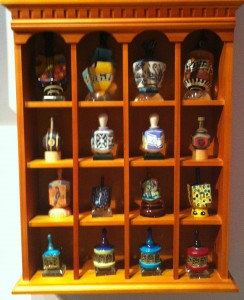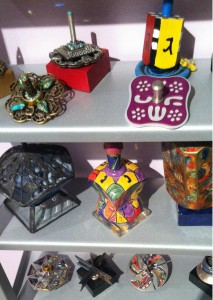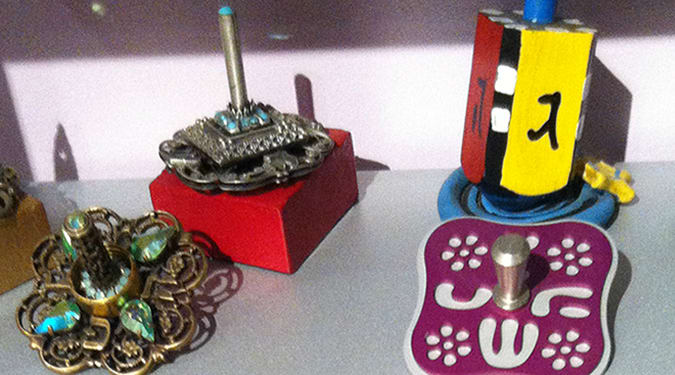Can a simple top, a delightful toy for children, really speak to me in the aftermath of tragedy? In the aftermath of a Har Nof?

Although some might suggest otherwise, questioning how a mere toy, could possibly carry the weight of such an event, I believe that the dreidel in fact can afford insight into how to wrestle with such difficult and seemingly unfathomable events. In doing so, it offers a hint to why I am so enamored with my ever-growing dreidel collection; a collection that I began almost thirteen years ago when I met my beloved wife. I remember that moment so clearly. It was the second night of Chanukah… yes, it was a miracle for me to have met my dear Clary. A Chanukah miracle. But even that remembrance begets a Chanukah question. In my heart, the dreidel came to symbolize that wonderful meeting and yet… wouldn’t a single grandiose dreidel have been enough to commemorate that life-transforming moment? Why did I feel moved – some might suggest compelled – to continue to amass dreidel after dreidel, growing my collection to nearly a thousand dreidels from the United States, from Israel, from Spain, Hungary, India, Russia, Scotland, Brazil… indeed, from all over the world. So many wondrous tops! So many that anyone who comes into the room where I keep my many volumes of books will find themselves transported by the sight of them.
No single dreidel for me, no! For me, hundreds of dreidels, made from a broad array of materials, coming in all sizes and colors.
But why more dreidels every year?
It is a rare visitor to our home who doesn’t view my collection and then, the smile fading from his or her face, “But, Rabbi Safran, of all the things in the world to collect, why dreidels?”
Ah, lest you think that my collection is simply whimsy, an opportunity to recall the delightful evenings of childhood when the joy of Chanukah filled my household, let me share with you my response. “What,” I ask, “does the dreidel teach us? What is its message?”

So much of Chanukah is presented in a way to delight young children. The dreidel and gelt. The sufganiyot. The games and songs commemorating the miracle of a small, dedicated army of fighters overcoming the vastly larger, fierce oppression of the Hasmoneons and rededicating our sanctuary.
And let us not forget the miracle of the oil!
But the story and challenge of Chanukah – and its ultimate miracle – is far beyond a child’s simple story. Likewise, all the elements of the telling are also more powerful and commanding than how they are often portrayed in the telling. Indeed, the “toy” dreidel does not represent simplicity at all but rather the complexity and hidden nature of history and miracles. It is our sense of self that leads us to think that our “brief moment on the stage” is what is important and that what we experience is, of necessity, the most important thing. However, just as the dreidel spins and lands with only one side up, history and experience also show us only some of reality. The four sides of the dreidel teach that we are never truly seeing “the whole story” and that there is always another side that remains hidden to us.
When we begin to grasp the deep truth of the dreidel, we come to understand that with so much beyond our understanding, we have to have faith in hidden miracles and in God. We cannot comprehend the meaning of Har Nof just as we cannot understand the countless other events that mark our long history.
* * *
So we return to the dreidel. Four panels. A nun, a pei or shin, a gimmel, and a hei. Four letters, representing the message of Chanukah – A great miracle happened here/there. As it spins and falls, showing one letter, it necessarily hides another. What is plain to us is only what we see. We too often fail to find comfort or meaning in what is hidden to us
When the dreidel “falls” on the hei we play the game, never considering that on the other side of the dreidel is the nun – neis for “miracle.” We see the “there was” but we are blind to the “miracle.” A gimmel – “great” – hides the pei/shin, the “here” or “there.”
We spin on and on and on, missing so many of God’s messages to us! Why? Because we see only that which is plain to us, failing to look deeper and finding that which is less obvious or hidden. However, our blindness does not mean that what is on the other side of the dreidel is not as equally important part of the reality that we perceive!
Bayamim hahem – in days of yore. What is vital is not what was but whether what was has everlasting value to us. Many of the holidays listed in Megillat Ta’anit are not celebrated because they fail this simple test. They have meaning only in their own time, in the past.
Chanukah – with its silly little dreidel – continues to be celebrated because its message and its power continues to speak to us today. Ba’zeman hazeh.
Bridging the near-insurmountable distance between hayamim hahem to ba’zeman hazeh is the mystical gift of our survival – physical, spiritual and religious. That same bridge – that carries us from the hei of the dreidel to the neis – is the same gift that has allowed the congregation of Har Nof to celebrate a bris the very next day!
A great miracle is happening here!
* * *
In “Days of Deliverance”, Rabbi Soloveitchik notes that Chanukah has a universal appeal; it is, “…a holiday of political victories, a holiday of the smashing of political might. Matityahu and his sons had the strength and the courage to confront the Syrian-Greek legions, to liberate the city of Jerusalem and its Temple, and to re-establish an independent Jewish kingdom. This history of dramatic bravery appeals to all, Jew and non-Jew, especially when the revolutionaries compose a small group, unorganized and poorly armed, yet unafraid of declaring war on a mighty enemy.”
However, having said that, he asks the deeper question, “Is Chanukah merely a holiday telling us a heroic story of battles won and political victories gained, like the American Fourth of July, or the French Fourteenth of July? A political event, even one of the greatest importance, can be celebrated only as long as the people view it as a turning point in history, the beginning of a new epoch in independence…. However a political victory loses its meaning when the people later lose their independence and the victory ends in a downfall.
“If Chanukah had been simply a holiday of political freedom, its whole meaning would have evaporated with the destruction of the Temple and the exile of the Jewish people. Chanukah’s fate would have been exactly like that of all the other holidays of the Second Temple era which were enumerated in Megillat Ta’anit.”
As clearly pointed out in the Talmud, One is forbidden to fast on those days that were named in Megillat Ta’anit when the Temple was in existence, because they were days of gladness to them. Once the Temple was no longer in existence, one was permitted to fast, because they are days of mourning to them (Rosh HaShanah 19b)
That being the case, “where is the logic in celebrating Chanukah during thousands of years of exile, martyrdom, ghettos, pogroms, and suffering? How small and worthless do the Maccabean victories seem when compared to the cruel political downfalls that we have suffered?”
Matityahu and his sons did not revolt due to political pressure. They, along with the people, were happy to accept their political suffering “with love.” It was the Greeks’ hatred for our spiritual essence, our difference, that is, our Torah. It was the same hatred that Haman felt when he complained, “Their laws are different from those of every people.” (Es. 3:8). It is the same hatred that we felt during the Holocaust and, indeed, at the most recent expression of that hatred, Har Nof.
Viewing that carnage, it is easy to understand Zaka’s director, Yehuda Meshi Zahav’s, statement that he had not experienced a scene such as he saw in Har Nof since looking at Holocaust pictures.

The comparison is true not only in the horrible images but on a deeper level. How did we celebrate a bris the day after the tragedy of Har Nof? How did we rebuild the Jewish nation after the Holocaust?
How can we comprehend such a rebirth? Just as the toppled dreidel is once again picked up to spin again, so too do we go on. The day after the tragedy at Har Nof there was davening, there was learning, there was celebration. Our DNA is defined by renewal. No one can stop us. We are God’s nation. He is Eternal. So then are we.
When we are gunned down in shul we return the next day to pray and to celebrate a baby boy’s bris. When the gates of Auschwitz slammed shut, the gates of Haifa opened!
Chanukah is not about Matityahu’s military victory. That did not last. What did last to this very day is the purification and renewal of Jewish life and lore. Difficult to grasp? Seems senseless? Walk the length and breadth of Israel – see for yourself!
In another essay, Rabbi Soloveitchik expresses similar thoughts. “One can see that which is revealed, but not that which is concealed. The Kabbalists speak about the antithesis between the hidden world, and the revealed world. These terms express the idea, that most things that humans can sense are only the last phase in a long evolutionary process that unfolded quietly, far from the perception of the human eye, which can discern only things that are ripe and complete.”
Rabbi Soloveitchik makes clear that the Hasmoneans fought not against an imperial power but for the purity of the Jewish soul, in their own time and forever. They fought and won to show that the people can be reborn and renewed. That is the miracle.
Spin, little dreidel, spin!
When the dreidel shows a gimel it is good to remember that, on the other, hidden side is the nun. There, sometimes hidden, untold miracles abound! We are all dreidels – we keep spinning. That’s why I continue to acquire more dreidels – the miracles of our continued and eternal existence never cease to create renewed amazement.
May we always seek the hidden and find the miraculous of the Eternal even when we are confronted by the pain of the temporal!
The words of this author reflect his/her own opinions and do not necessarily represent the official position of the Orthodox Union.

